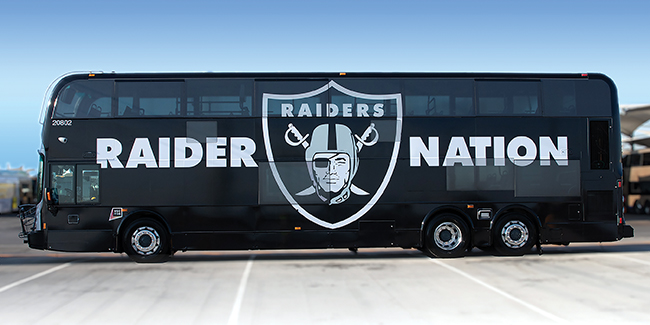
(Upper Photo: RTC and Las Vegas Raiders partnered to provide Game Day Express service this season to Allegiant Stadium from five convenient locations In Southern Nevada.)
By Emma Green
Overseeing public transportation, traffic management, roadway design, construction funding, transportation planning and regional planning efforts, the Regional Transportation Commission (RTC) of Southern Nevada serves as both the transit authority and the transportation-planning agency for Southern Nevada.
As RTC continues to expand its many services, the physical infrastructure it is responsible for grows increasingly more complex, relying on collaboration between multiple departments. Historically this has meant each utilizing their own method of tracking, preventative maintenance, and numbering conventions for assets.
“It is about breaking down barriers between departments, and even our own business partners,” said Theresa Rand, RTC senior system administrator of enterprise asset management (EAM). “There are tons of asset management systems out there, but for our needs, Trapeze was the right product.”
Unlike asset management software used to manage factories or manufacturing plants, Trapeze EAM is catered specifically to the transit market. Trapeze’s EAM solution covers rolling stock such as bus, rail, and paratransit vehicles, as well as facilities, bus stops, and all infrastructure.
According to Satpal Bamrah, EAM implementation lead at Trapeze, there are many workflows seen in transit that are not common in other industries.
“Because these are unique needs which we see in the transit space, our system is set up and able to support those needs natively,” Bamrah said. Screens and features are specially designed for transit roles such as asset manager, supervisor, technician, or warranty administrator and those associated workflows. Other features focus on asset availability and condition, state of good repair, inspection compliance, incident management, National Transit Database (NTD) reporting, and more.

During the procurement process, RTC staff conducted multiple site visits to a variety of transit agencies using various EAM solutions. Rand noted that during their demo, Trapeze EAM showed a higher success rate than the other vendors due to its transit-specific features and use of organizational change management as part of their deployment approach.
“Our leadership realized what a big implementation EAM would be, and how it would lead to some significant changes in each of the departments’ business processes,” Rand said.
Having formal change management is a key success factor of the project, and with all Trapeze staff “speaking transit fluently,” RTC leadership felt that would significantly reduce project risk and lead to a more successful project.
The decision was made to move forward with Trapeze EAM, and RTC’s fixed route and paratransit contractors were quickly looped in as part of the change management system, providing a streamlined reporting process between allied businesses. Accessing automated compliance reporting has enabled RTC to easily oversee various Operating & Maintaining (O&M) partners, all based on specific contract requirements for each.
“It touches our entire agency and business partners,” Rand explained. “Many of our departments are utilizing the system on a daily basis, using it to record the work that’s performed for our assets including fleet buses, paratransit, facilities departments, all of our buildings and everything in them. It has become a very important tool for our entire agency.”
The system also includes a robust preventive maintenance (PM) program, easily tailored to fit RTC’s inspection type. The program provides RTC with the ability to report on individual PM checklist items, automate work requests from failed items, and view and report scheduling charts.
“In transit, it can be hard to get a perspective on, ‘am I doing things in the most efficient way?’” Bamrah said. “But if you can learn one thing from one department and apply it to another, then you can put that all into one system and generate a huge amount of data that will lead to insights that you may not have had before.”
